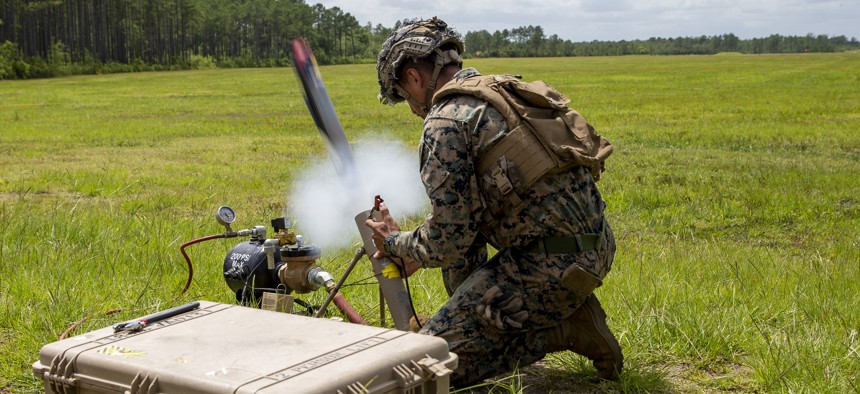
Marine Corps Lance Cpl. Isiah Enriquez launches a Switchblade drone during a training exercise at Camp Lejeune, N.C., on July 7, 2021. U.S. Army
Army orders loitering munition for testing as soldier-borne tank-killer
Service will send Switchblade 600s to U.S. units for evaluation.
The U.S. Army has chosen AeroVironment’s Switchblade 600 for the first step in a new program designed to put tank-killing loitering munitions in the hands of average soldiers, following the example seen in Ukraine.
Army units tasked with testing will receive more than 100 Switchblades for initial testing and fielding, Doug Bush, assistant Army secretary for acquisition, told Defense One at AUSA.
Other companies will be invited to compete after the conclusion of the program’s increment one, Bush said.
“There'll be entry points for other vendors, potentially, because there's so much innovation in that space,” he said.
Dubbed the Low Altitude Stalking and Strike Ordnance, or LASSO, program, the three-month-old effort aims to give infantry brigade combat teams one or more weapons that can be launched by soldiers to destroy or disable an enemy tank.
The effort follows the successful use of loitering munitions by both sides in Ukraine: U.S.-provided Switchblade 600s and other weapons by the defenders, artillery-busting versions by the invaders.
The Switchblade 600 is designed to destroy tanks, and has a range of up to 24 miles and a loiter time of over 40 minutes. Once it finds a target, it can sprint to a speed of 115 miles per hour. Its accuracy can be further increased by using secondary drones as spotters, a Ukrainian drone team operating in Bakhmut told Defense One.
AeroVironment has not published a price for the Switchblade 600. Budget documents suggest that its smaller cousin, the Switchblade 300, might cost roughly $80,000 apiece; the larger Switchblade 600 would presumably cost more—though would likely remain well south of the $176,000 price tag for a Javelin, the Army’s main soldier-borne anti-tank weapon.
Ukraine, by contrast, mostly fields far cheaper commercial quadcopters, including first-person-view racing drones that are jerry-rigged with various munitions.
Bush said that the success of such systems may be overstated. “There's an impression you can get from watching YouTube videos that may not match reality,” he said. “So you might see the one attack out of 30, where the little drone with the RPG got lucky and worked, but you didn't see the other 29 where it got jammed and crash, got shot down, or hit the tank and didn't do anything, because it didn't in the right place.”
Correction: The original version of this story misspelled the name of the company the Army chose. It is AeroVironment.




